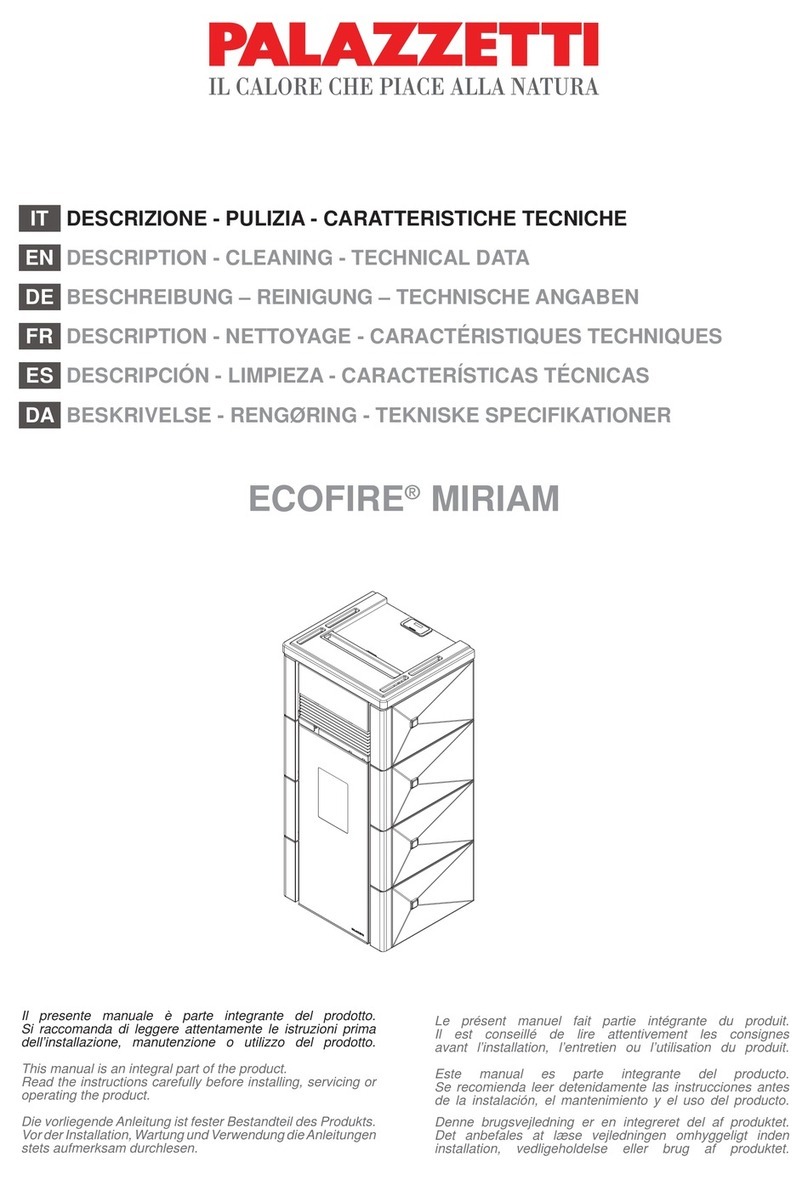
4
Positioning
The adjacent locale must not be used as
a garage or be a space without ventila-
tion or air exchange, a storage area for
combustible material or used for an
activity that has a fire hazard.
S oke discharge
The discharge system must be for the stove
only (it is not permissible to discharge into flues
in common with other devices).
The smoke discharge takes place through the 8
cm diameter tube placed at the back (Pict. 3).
A “T” with a condensation collection cap
should be provided.
The smoke discharge of the stove must be
connected with the outside using a steel or
black tube (resistant up to 450°C) without
obstructions.
The tube must be hermetically sealed.
To make the tubes airtight and for their even-
tual insulation, it is necessary to use material
resistant up to at least 300°C (silicone or putty
for high temperatures).
The horizontal sections can be up to 2 m long.
It is possible to have up to three 90° curves.
If the discharge tube does not insert in the
flue, an opportunely fastened vertical section
of at least 1.5 m is necessary (except for evi-
dent safety contraindications) and a wind-
proof termination (Pict.3). The vertical duct
can be inside or outside. If the smoke duct is
outside it must be insulated (Pict.4).
If the smoke duct is inserted in a flue, this
must be certified for solid combustibles and if
it is larger than 150 mm in diameter, modifica-
tion is necessary by inserting a tube and seal-
ing the discharge with respect to the parts in
brickwork.
It must be possible to inspect all the sections
of the smoke duct. If it is a fixed duct it must
have openings for inspection and cleaning.
External air intake
The stove must be furnished with the air neces-
sary to guarantee the regular functioning of the
combustion and an environmental well being.
• Be sure that the room where the stove is
installed has sufficient aeration and, if
necessary, install an air intake duct with a
minimum recommended diameter of 50 mm
to bring in air from the outside.
• The external air intake must communicate
with the stove and positioned so that it is
not obstructed. It must be protected with a
permanent non-closable grill or other suita-
ble protection provided that the minimum
diameter is not reduced.
• The air flow can also be acquired from a
locale adjacent to where the stove is instal-
led as long as that flow can freely cross the
permanent non-closable openings that
communicate with the outside.
• The presence in the local adjacent to where
the stove is installed, of other devices in use
or of suction devices that cause a contrary
draught effect must not create a lower air
pressure in the locale than in the outside
environment.
• In the adjacent locale the permanent ope-
nings must respond to the requisites which
are listed in the points above.
530±10 mm. 689±10 mm.
590±10 mm.
Pict. 3 Sizing of the fire lace
80mm
ø 48/50 mm
190±10 mm.



























